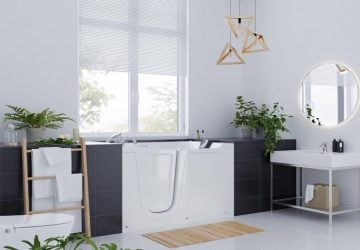- Published on
Discover the Ultimate Bathroom Upgrade: A Walk-In Tub for Enhanced Safety and Comfort!
Discover the Ultimate Bathroom Upgrade: A Walk-In Tub for Enhanced Safety and Comfort!
Creating a bathroom that prioritizes safety and accessibility is crucial, particularly for elderly people or those facing challenges with movement. A key solution to enhance bathroom safety is the installation of a walk-in tub. This decision is not about choosing any model; it necessitates a deep understanding of how this feature can revolutionize your bathroom into a secure haven. This article explores the safety benefits of walk-in tubs and highlights important considerations to tailor it to the user's specific needs.

Traditional bathrooms pose risks, particularly with their slick surfaces. Conventional bathtubs can be dangerous, requiring users to step high and balance on wet surfaces, creating a heightened potential for falls. Recognizing the hazards can lead to identifying better options for those in need of greater safety, like seniors or individuals with mobility impairments. Walk-in tubs come designed to alleviate the dangers inherent to standard bathroom setups. These tubs boast a low-entry threshold due to their watertight doors, simplifying entry and exit without the need to navigate raised borders. Typically, they also include built-in seating, which eliminates the risk associated with lowering oneself onto the tub's floor. Such design choices collectively minimize the chance of falling, a prevalent source of injuries among older populations. These tubs include integrated safety components beyond their fundamental design. Features like non-slip floors and seats lessen the likelihood of slipping, while strategically placed grab bars provide additional support. To protect from burns, anti-scald valves help maintain a safe water temperature, while essential emergency features ensure the tub's door can open during power failures or other unforeseen circumstances. For comfort—and safety—additional elements like hydrotherapy and air jets can substantially aid the user's well-being. Soothing water jets offer relief to sore muscles and enhance mobility, while air jets invigorate the skin and boost circulation. Water heaters within the tub can keep the temperature consistent, avoiding the potential dangers associated with abrupt temperature shifts. These comforts also inherently offer users a physical advantage by reducing the risks of accidents. Customization is key to meeting specific individual needs within the array of walk-in tub options. Depending on mobility limitations, tubs can be fitted with broader entrances, a higher number of support bars, or features to accommodate wheelchair-bound users. A personalized approach to a walk-in tub can magnify its safety benefits, leading to greater peace of mind and enhancing life quality. For optimal safety, professional installation is non-negotiable. A professional's work ensures that the tub is stable, level, and that all safety and electrical components are functioning correctly. Additionally, it is imperative to educate users on how to use the tub's features correctly—such as operating the door lock or adjusting jet settings—which amplifies the safety benefits. Safety for the user also encompasses emotional reassurance. When a space initially fraught with danger becomes secure, it eases anxieties for the user and their family. This newfound security fosters greater self-confidence, autonomy, and mental wellness—factors vital to comprehensive health that often go unnoticed. In conclusion, integrating a walk-in tub into your bathroom advances the safeness and overall ambience of the living environment. Beyond preventing physical mishaps, the tub supports therapeutic and emotional well-being. By addressing these vital elements and selecting a walk-in tub that fits the user’s unique requirements, you are building more than just a secure setting. You're providing a safeguard that not only protects but uplifts the quality of life for the future.